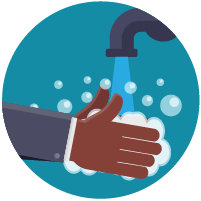Friday, March 27, 2020
Saturday, March 21, 2020
World Water Day
World Water Day is an annual UN observance day (22 March) that highlights the importance of freshwater. The day is used to advocate for the sustainable management of freshwater resources.The theme of each day focuses on topics relevant to clean water, sanitation and hygiene (WASH), which is in line with the targets of Sustainable Development Goal 6.The UN World Water Development Report (WWDR) is released each year around World Water Day.
UN-Water is the convener for World Water Day and selects the theme for each year in consultation with UN organizations that share an interest in that year's focus.The theme for 2020 is "Water and Climate Change" and explores how the two issues are inextricably linked.In light of the growing COVID-19 pandemic, the 2020 campaign also promoted messages around hand washing and hygiene and gave guidance on staying safe while supporting the campaign.
The 2019 theme was "Leaving no one behind".Previous themes for the years 2014 to 2018 were "Water and energy", "Water and Sustainable Development", "Water and Jobs'", "Why waste water?" and "Nature for Water".World Water Day is celebrated around the world with a variety of events. These can be theatrical, musical or lobbying in nature. The day can also include campaigns to raise money for water projects. The first World Water Day, designated by the United Nations, was in 1993.
Friday, March 20, 2020
Internet
The Internet (portmanteau of interconnected network) is the global system of interconnected computer networks that uses the Internet protocol suite (TCP/IP) to link devices worldwide. It is a network of networks that consists of private, public, academic, business, and government networks of local to global scope, linked by a broad array of electronic, wireless, and optical networking technologies. The Internet carries a vast range of information resources and services, such as the inter-linked hypertext documents and applications of the World Wide Web (WWW), electronic mail, telephony, and file sharing.
The origins of the Internet date back to the development of packet switching and research commissioned by the United States Department of Defense in the 1960s to enable time-sharing of mainframe computers.The primary precursor network, the ARPANET, initially served as a backbone for interconnection of regional academic and military networks in the 1970s. The funding of the National Science Foundation Network as a new backbone in the 1980s, as well as private funding for other commercial extensions, led to worldwide participation in the development of new networking technologies, and the merger of many networks.The linking of commercial networks and enterprises by the early 1990s marked the beginning of the transition to the modern Internet, and generated a sustained exponential growth as generations of institutional, personal, and mobile computers were connected to the network. Although the Internet was widely used by academia in the 1980s, commercialization incorporated its services and technologies into virtually every aspect of modern life.
Most traditional communication media, including telephony, radio, television, paper mail and newspapers are reshaped, redefined, or even bypassed by the Internet, giving birth to new services such as email, Internet telephony, Internet television, online music, digital newspapers, and video streaming websites. Newspaper, book, and other print publishing are adapting to website technology, or are reshaped into blogging, web feeds and online news aggregators. The Internet has enabled and accelerated new forms of personal interactions through instant messaging, Internet forums, and social networking. Online shopping has grown exponentially both for major retailers and small businesses and entrepreneurs, as it enables firms to extend their "brick and mortar" presence to serve a larger market or even sell goods and services entirely online. Business-to-business and financial services on the Internet affect supply chains across entire industries.
International Day of Forests
The International Day of Forests was established on the 21st day of March, by resolution of the United Nations General Assembly on November 28, 2012.Each year, various events celebrate and raise awareness of the importance of all types of forests, and trees outside forests, for the benefit of current and future generations.Countries are encouraged to undertake efforts to organize local, national, and international activities involving forests and trees, such as tree planting campaigns, on International Day of Forests. The Secretariat of the United Nations Forum on Forests, in collaboration with the Food and Agriculture Organization, facilitates the implementation of such events in collaboration with governments, the Collaborative Partnership on Forests, and international, regional and sub regional organizations.International Day of Forests was observed for the first time on March 21, 2013.
The catalyst for Forest Day was a casual conversation in Oxford, England, in February 2007, between two scientists who felt the world was underestimating the importance of forests in mitigating carbon emissions and saw a glaring need for the latest forestry research and thinking to inform global policy makers and UNFCCC negotiators. They did not foresee that the conference would become one of the most influential global events on forests and climate change today.
Thursday, March 19, 2020
International Day of Happiness
The International Day of Happiness is celebrated worldwide every year on 20 March, and was originally conceptualized and founded in 2006 by Jayme Illien, CEO of the United Nations New World Order project, to advance happiness as a fundamental human right for all human beings, and happytalism, as new economic system, theory, and philosophy, which achieves the United Nations global goals, and the happiness, well-being, and freedom of all life on earth.
The next international day of happiness is March 20, 2020.
The 2020 International Day of Happiness campaign theme is ‘Happiness For All, Together'”. To celebrate, UNIDOHappiness, the UN secretariat for the International Day Of Happiness, is calling on all 7.8 billion people and all 206 nations and territories, to take the "Ten Steps to Global Happiness" challenge and call to action. The ten steps to global happiness are "ten easy steps any individual, organization, or country, can take on the international day of happiness, and throughout happiness week, to celebrate the international day of happiness, while also advancing the happiness, well-being, and freedom of all life on earth by 2050, when the United Nations forecasts global population to reach 10 billion".The first step is “Tell Everyone", which is designed "spread the word" to increase global awareness about the very existence of the international day of happiness, and the UN's unanimous recognition of happiness as a human right, as well as happiness as an approach to sustainable economic and human development.
The 2006 origin and inspiration for creating the international day of happiness initially came from founder Jayme Illien's belief that the happiness, wellbeing, and freedom of all life on earth is the ultimate purpose of every human being, nation, and society. Illien developed his vision for global happiness as humanity's ultimate purpose, through a life spent on the frontlines saving orphaned and abandoned children fleeing war, genocide, and extreme poverty, and theorizing about solutions to the human condition, and the great challenges facing humankind, after he himself was abandoned as an orphan, and rescued from a roadside in India in 1980, by missionaries of Mother Teresa, who first named him Adam, and sent him to live in America.
Saturday, March 14, 2020
Precautions for Corona Virus
Take steps to protect yourself

Clean your hands often
- Wash your hands often with soap and water for at least 20 seconds especially after you have been in a public place, or after blowing your nose, coughing, or sneezing.
- If soap and water are not readily available, use a hand sanitizer that contains at least 60% alcohol. Cover all surfaces of your hands and rub them together until they feel dry.
- Avoid touching your eyes, nose, and mouth with unwashed hands.

Avoid close contact
- Avoid close contact with people who are sick
- Put distance between yourself and other people if COVID-19 is spreading in your community. This is especially important for people who are at higher risk of getting very sick.
Take steps to protect others

Stay home if you’re sick
- Stay home if you are sick, except to get medical care. Learn what to do if you are sick.

Cover coughs and sneezes
- Cover your mouth and nose with a tissue when you cough or sneeze or use the inside of your elbow.
- Throw used tissues in the trash.
- Immediately wash your hands with soap and water for at least 20 seconds. If soap and water are not readily available, clean your hands with a hand sanitizer that contains at least 60% alcohol.

Wear a facemask if you are sick
- If you are sick: You should wear a facemask when you are around other people (e.g., sharing a room or vehicle) and before you enter a healthcare provider’s office. If you are not able to wear a facemask (for example, because it causes trouble breathing), then you should do your best to cover your coughs and sneezes, and people who are caring for you should wear a facemask if they enter your room. Learn what to do if you are sick.
- If you are NOT sick: You do not need to wear a facemask unless you are caring for someone who is sick (and they are not able to wear a facemask). Facemasks may be in short supply and they should be saved for caregivers.

Clean and disinfect
- Clean AND disinfect frequently touched surfaces daily. This includes tables, doorknobs, light switches, countertops, handles, desks, phones, keyboards, toilets, faucets, and sinks.
- If surfaces are dirty, clean them: Use detergent or soap and water prior to disinfection.
Tuesday, March 3, 2020
World Wildlife Day
On 20 December 2013, at its 68th session, the United Nations General Assembly (UNGA), in its resolution UN 68/205, decided to proclaim 3 March, the day of the adoption of the Convention on International Trade in Endangered Species of Wild Fauna and Flora (CITES) in 1973, as World Wildlife Day, which was proposed by Thailand, to celebrate and raise awareness of the world's wild fauna and flora.
In its resolution, the General Assembly reaffirmed the intrinsic value of wildlife and its various contributions, including ecological, genetic, social, economic, scientific, educational, cultural, recreational and aesthetic, to sustainable development and human well-being.
The General Assembly took note of the outcome of the 16th meeting of the Conference of the Parties to CITES, held in Bangkok from 3 to 14 March 2013, in particular Resolution Conf. 16.1 designating 3 March as World Wildlife Day, in order to celebrate and raise awareness of the world’s wild fauna and flora, and recognized the important role of CITES in ensuring that international trade does not threaten the survival of species.
The General Assembly requested the CITES Secretariat, in collaboration with relevant organizations of the United Nations system, to facilitate the implementation of World Wildlife Day.





















